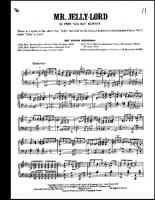
This house was renovated after Hurricane Katrina by Jack Stewart, a general contractor and preservationist, and rented to musicians. His style mingled aspects of his classical music background with the blues, and used Afro-Cuban rhythms like the habanera to create a sound he referred to as the “Spanish tinge.” His compositions such as “Jelly Roll Blues” and “Black Bottom Stomp” are considered some of the finest jazz songs from the period. He became a hustler, and ran with a rough crowd. Nevertheless, as a young man he earned money playing piano at some of the finest brothels in Storyville. While Morton’s family appreciated music, especially at the French Opera House, they did not regard playing it as a worthy vocation for him. We always had ample time that was given to us in periods to rehearse our lessons, anyone that was desirous of accepting lessons.” We had lots of them and everybody always played for their pleasure-whatever ones desired to play. “We always had some kind of musical instruments in the house including guitar, drums, piano, trombone, and so forth and so on. As a youth, Morton studied several instruments formally, but eventually took up the piano, for which he is best known. He grew up here in a community of Creoles of color, many of whom were French-speaking, educated Catholics descended from gens de couleur libres (free people of color).

Morton’s family name was probably LaMothe-the Anglicized “Morton” was his own creation (for its part, “Jelly Roll” was a sexual term). He often said that he invented jazz single-handedly while this is an exaggeration, he was instrumental in the development of the form.

Morton was one of the greatest pianists, composers, arrangers and bandleaders of early jazz. Jazz has always included what Jelly Roll Morton referred to as a ‘Spanish tinge’, dating back to the music’s origins in the melting pot of New Orleans in the early 20th Century. This Creole cottage is the home where Ferdinand “Jelly Roll” Morton (ca.


 0 kommentar(er)
0 kommentar(er)
